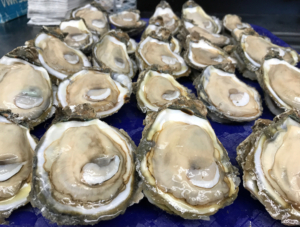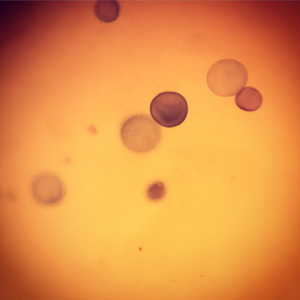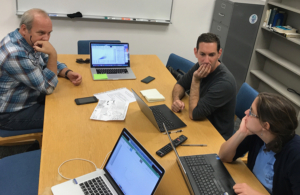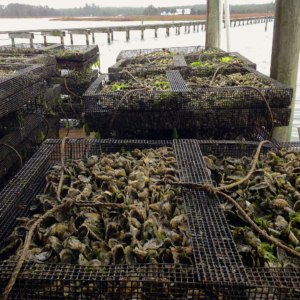Scientists and managers have long thought that disease spreads from oyster aquaculture to wild populations. New research, however, has shown that aquaculture operations can actually limit the spread of diseases like dermo. The team, including Tal Ben-Horin of the University of Rhode Island (URI), Colleen Burge of University of Maryland Baltimore County (UMBC), Ryan Carnegie of the Virginia Institute of Marine Science (VIMS), among others, recently published their findings in Aquaculture Environment Interactions.

Oysters on the half shell in the lab. Credit: Ryan Carnegie.
Many stakeholders opposed to oyster aquaculture have pointed to the density of oysters grown on farms as potential breeding grounds for disease. Meanwhile, scientists and managers have been promoting aquaculture for its potential benefits to water quality, as oysters can filter out particles and pollutants at high rates. It turns out that this filtration ability is exactly what makes oysters a great sink for disease. “The oysters are filtering vast quantities of water and removing planktonic material that includes infectious particles,” explained Carnegie. “They are decreasing the amount of infectious particles that are drifting in the waters, making those diseases less available to wild oysters.”

Dermo, formally known as Perkinsus marinus.
Farmed oysters that are grown in cages are well managed by the farmers: the farmers know where all of the oysters are and when they are ready for harvest. Dermo is primarily transmitted once the oyster it has infected dies, so if oysters are harvested before they are killed by dermo, they are limited in how much disease they can spread. “If you’re running your business right, you’re getting the oysters out of the water before a lot of dermo-caused mortality happens,” explained Carnegie. In addition, infected oysters pose no risk to humans, so the farmed oysters are an end point for the disease.
Intensive aquaculture is the mode most likely to benefit wild oyster populations. In intensive farming, all oysters are caged and harvested on a strict schedule. In contrast, extensively-farmed oysters are grown uncaged on the estuary bottom. Some extensively planted oysters are never removed, and many of these will end up dying of and spreading the disease.

Some of the paper’s authors, from left to right: David Bushek, Ben-Horin, and Maya Groner.
Carnegie, who has been studying disease in oysters for years, was excited to team up with Ben-Horin and others on a model that would explain this phenomenon. The model considered the rate of acquisition of infection in wild and farmed oysters, the rate of disease release in farmed animals, the length of time farmed oysters stayed in the water, and the disease resistance or tolerance of the oysters. They were interested in looking at different methods of oyster aquaculture and how harvesting could affect infection rates.
Carnegie wants to better understand how the disease has evolved over time, and how we might use this information to better manage oysters, in the wild and in aquaculture. “We need to know how the oysters and pathogens are changing over time, how they are interacting, and what is driving changes to virulence and resistance,” he explained.

Oyster cages. Credit: VIMS
The team is optimistic that aquaculture can continue to thrive in disease-prone areas, such as high-salinity waters where diseases are intense but oysters grow quickly. “Just as we have argued in oyster restoration, we continue to find justification in aquaculture for taking the battle to the parasites on their turf in higher salinity waters,” said Carnegie. “The vast bulk of oyster aquaculture is conducted in high-disease parts of the Bay region. Growers are getting oysters to market size despite the ubiquitous presence of dermo, as well as MSX disease. They are making it work.”
